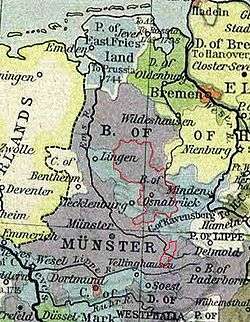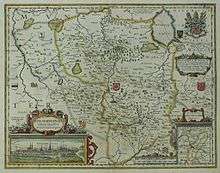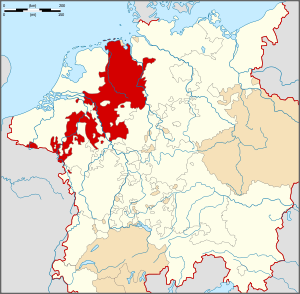Prince-Bishopric of Osnabrück
| Prince-Bishopric of Osnabrück | ||||||||||
| Hochstift Osnabrück | ||||||||||
| State of the Holy Roman Empire | ||||||||||
| ||||||||||
|
| ||||||||||
 Prince-Bishopric of Osnabrück in 1786 (red line). | ||||||||||
| Capital | Osnabrück | |||||||||
| Languages | Low Saxon, German | |||||||||
| Religion | Roman Catholic until the 1540s, then also Lutheran | |||||||||
| Government | Principality | |||||||||
| Historical era | Middle Ages | |||||||||
| • | Created on collapse of Saxony |
1225 | ||||||||
| • | Secularised to Hanover |
1803 | ||||||||
| ||||||||||
The Prince-Bishopric of Osnabrück (German: Hochstift Osnabrück[1]) was a state of the Holy Roman Empire from 1225 until 1803. It was the territory of princely rule held by the incumbents of the Diocese of Osnabrück (German: Bistum Osnabrück), therefore wielding secular and religious functions as prince-bishops. It was named after its capital, Osnabrück.
The still extant Diocese of Osnabrück, erected in 772, is the oldest see founded by Charlemagne, in order to Christianize the conquered stem-duchy of Saxony. The episcopal and capitular temporal possessions of the see, originally quite limited, grew in time, and its prince-bishops exercised an extensive civil jurisdiction within the territory covered by their rights of Imperial immunity. The Prince-Bishopric continued to grow in size, making its status during the Reformation a highly contentious issue.
In the German Mediatisation of 1803, the bishopric was dissolved when the last bishop was Prince Frederick, Duke of York and Albany. The secular or temporal power given to the Hanover branch of Brunswick-Lüneburg; the see, the chapter, the convents and the Catholic charitable institutions were secularized. The territory of the see passed to Prussia in 1806, to the Kingdom of Westphalia in 1807, to Napoleonic France in 1810, and again to Hanover in 1814.
With the end of the prince-bishopric also the future of the diocese became unclear. Klemens von Gruben, titular Bishop of Paros in Greece, was made vicar apostolic of Osnabrück, and as such cared for the spiritual interests of the Catholic population. The ordinary Latin (Roman) Catholic episcopacy was restored in 1824, but henceforth the bishops would no longer wield any temporal power.
History
The temporal protectorate (Latin: Advocatia; German: Vogtei) exercised over so many mediaeval dioceses by laymen became, after the 12th century, hereditary in the Amelung family, from whom it passed to Henry the Lion.
After Henry's overthrow, it came into the possession of Count Simon of Tecklenburg and his descendants, though it was the source of many conflicts with the bishops. In 1236 the Count of Tecklenburg was forced to renounce all jurisdiction over the town of Osnabrück as well as the lands of the see, the chapter and the parish churches. On the other hand, the bishop and chapter, from the 13th century on, expanded their jurisdiction over many convents, churches and hamlets. Scarcely any other German see freed itself so thoroughly from civil jurisdiction within its territory. The royal prerogatives were transferred little by little to the bishop, e.g. the holding of fairs and markets, rights of toll and coinage, forest and hunting rights, mining royalties and fortresses so that, by the early part of the 13th century, the bishop was the real governor of the civil territory of Osnabrück.
Among the prominent mediaeval bishops were Drogo (952–68); Conrad of Veltberg (1002); the learned Thietmar or Detmar (1003–22); Benno II (1067–88); Johann I (1001–10), who built the actual cathedral in place of the wooden one destroyed by fire in the time of his predecessor; Diethard I (1119–37) was the first bishop elected by the free choice of the cathedral clergy; Philip II (1141–73) ended the conflicts between his see and the Imperial Abbeys of Corvey and Hersfeld; Arnold of Berg (1137–91) died a crusader at Akkon. In the time of Engelbert of Altena-Isenberg (1224–26, deposed following his implication in Archbishop Engelbert II of Berg's assassination, rehabilitated 1238–50), Bruno of Altena-Isenberg (1250–59), and under Conrad II of Rietberg (1269–97) the new orders of Franciscans, Dominicans and Augustinians were received with favour.
14th to 16th centuries
In the 14th and 15th centuries, the power of the bishops waned before the increasing influence of the cathedral chapter, of the military servants (or knights) of the diocese, and of the town of Osnabrück. The last sought to free itself from the bishop's sovereignty, but never became a Free City of the Empire. The see was almost continually engaged in warlike troubles and difficulties and had even to defend itself against the Bishops of Minden and Münster. From the 14th century auxiliary bishops became necessary due to the civil duties that absorbed the attention of the bishop himself.
The successor of Bishop Conrad IV of Rietberg (1488–1508) was Eric of Brunswick (1508–32), simultaneously Bishop of Münster and Paderborn. He opposed the Reformers strongly and successfully. Franz of Waldeck (1533–53), also Bishop of Minden, acted, on the contrary, a very doubtful part. He offered little resistance to Lutheranism in Münster, though he vigorously opposed the Anabaptists; after 1543 he allowed in Osnabrück an evangelical service. However, the chapter and the Dominicans opposed a German service that dispensed with all the characteristics of the Roman Catholic Mass. In 1548, Bishop Franz promised to suppress the Reformation in Osnabrück and to execute the Augsburg Interim, but fulfilled his promise very indifferently; on his deathbed he received Lutheran communions. His successor, John IV of Hoya (1553–74), was more Catholic, but was succeeded by three bishops of a Protestant mind: Henry III of Saxony (1574–85), Bernhard of Waldeck (1585–91), and Philip Sigismund (1591–1623). Under them the Reformation overran nearly the whole diocese.
17th and 18th centuries
In 1624, Cardinal Eitel Frederick of Hohenzollern became Bishop of Osnabrück and called in the Jesuits. However, he died soon afterwards. His successor, Francis of Wartenberg (1625–61), fulfilled the task of imposing the Counter-Reformation decrees. The city-council was purged of anti-Catholic elements and the former Augustinian convent was turned over to the Jesuits. The Edict of Restitution was executed successfully by him and in 1631 he founded a university at Osnabrück.

But in 1633, Osnabrück was captured by the Swedes: the university was discontinued, Catholic religious exercises suppressed, and the see (1633–51) administered by the conquerors. By the Peace of Westphalia in 1648, the bishop succeeded in preventing the secularisation of the see, as contemplated by the Swedes. Nevertheless, it was stipulated that henceforth a Catholic and a Protestant bishop (of the Augsburg Confession) would alternately hold the see. During the those periods of rule by a Protestant bishop, always chosen from the ducal House of Brunswick-Lüneburg, the spiritual care of the Catholics was committed to the Archbishop of Cologne.
Wartenberg was made cardinal in 1660 and was succeeded by the married Protestant bishop, Ernest Augustus (1661–98), who transferred the residence to Hanover. He was succeeded by the Catholic bishop, Prince Charles Joseph of Lorraine, Bishop of Olmütz, later Archbishop of Trier (1698–1715). The Protestant bishop Ernest Augustus (1715–28) was succeeded by Clemens August of Bavaria, Archbishop-Elector of Cologne (1728–61). The last bishop, Prince Frederick of Great Britain (1764–1803), later Duke of York, was, until his majority (1783), under the guardianship of his father, George III, monarch of the United Kingdom and Hanover. Prince Frederick was only six months old when he was appointed bishop.
Residence
From about 1100, after the fire which destroyed the cathedral in Osnabrück the Bishops had their residence in the Iburg Castle. This period ended when Ernest Augustus built a baroque castle in Osnabrück, the castle being was finished in 1673.
Bishops
- Wiho I. ( Wicho I) 783 to 1. April 809
- Meginhard 810 to 12. April 829
- Goswin 829–845
- Gosbert 845 to 11. April 860
- Eckbert 860 to 1. February 887
- Egilmar 887 to 11. May 906
- Bernhard I. 906–918
- Dodo I. 918 to 14. May 949
- Drogo 949 to 7. November 967
- Ludolf 967 to 31. March 978
- Dodo II. 978 to 12. April 996
- Kuno 978–980 (counter-bishop)
- Günther 996 to 27. November 1000
- Wodilulf 998 to 17. February 1003
- Dietmar 1003 to 18. June 1022
- Meginher 1023 to 10. December 1027
- Gozmar 1028 to 10. December 1036
- Alberich 1036 to 19. April 1052
- Benno I. (Werner) 1052–03. December 1067
- Benno II (Bernhard) 1068 to 27 July 1088
- Marquard 1088–1093
- Wicho II. 1093 to 21. April 1101
- Johann I. 1101 to 13. July 1109
- Gottschalk von Diepholz 1109 to 1. January 1119
- Diethard 1119–1137
- Konrad 1119–1125 (counter-bishop)
- Udo von Steinfurt 1137 to 28. June 1141
- Philipp von Katzenelnbogen 1141 to 15. June 1173
- Wezel 1141 (counter-bishop)
- Arnold von Altena 1173–1190
- Gerhard I. von Oldenburg-Wildeshausen 1190–1216
- Adolf von Tecklenburg 1216–1224
List of Prince-Bishops
Prince-Bishops of Osnabrück include:
- 1224–1226: Engelbert I von Isenberg
- 1206–1227: Otto I
- 1227–1239: Konrad I von Velber
- 1239–1250: Engelbert I von Isenberg
- 1251–1258: Bruno von Isenberg
- 1259–1264: Balduin von Rüssel
- 1265–1269: Widukind von Waldeck
- 1270–1297: Konrad von Rietberg
- 1297–1308: Ludwig von Ravensberg
- 1309–1320: Engelbert II von Weyhe
- 1321–1349: Gottfried von Arnsberg
- 1350–1366: Johann II Hoet
- 1366–1376: Melchior von Braunschweig-Grubenhagen
- 1376–1402: Dietrich of Horne
- 1402–1410: Henry I of Schauenburg-Holstein
- 1410–1424: Otto von Hoya
- 1424–1437: Johann III von Diepholz
- 1437–1442: Erich von Hoya
- 1442–1450: Heinrich von Moers
- 1450–1454: Albert von Hoya
- 1454–1455: Rudolf von Diepholz
- 1455–1482: Konrad III von Diepholz
- 1482–1508: Konrad IV von Rietberg
- 1508–1532: Eric of Brunswick-Grubenhagen
- 1532–1553: Franz von Waldeck (Lutheran after 1543)
- 1553–1574: Johann II von Hoya (Catholic)
- 1574–1585: Henry II of Saxe-Lauenburg (Lutheran)
- 1585–1591: Bernhard von Waldeck (Lutheran)
- 1591–1623: Philip Sigismund of Brunswick-Wolfenbüttel (Lutheran)
- 1623–1625: Eitel Frederick von Hohenzollern-Sigmaringen (Catholic)
- 1625–1634: Franz Wilhelm von Wartenberg (Catholic)
- 1634–1648: Gustav Gustavsson af Vasaborg (Lutheran)
- 1648–1661: Franz Wilhelm von Wartenberg (Catholic)
- 1662–1698: Ernest Augustus, Elector of Brunswick-Lüneburg (Lutheran)
- 1698–1715: Charles Joseph of Lorraine (Catholic)
- 1715–1728: Ernest Augustus, Duke of York and Albany (Lutheran)
- 1728–1761: Klemens August of Bavaria (Catholic)
- 1764–1802: Prince Frederick, Duke of York and Albany (Lutheran), last Prince-Bishop
The prince-bishopric was mediatized in 1803 to the Electorate of Hanover. For Catholic bishops after the mediatization, see Roman Catholic Diocese of Osnabrück.
Notes
- ↑ Also known as the Prince-Bishopric of Osnaburg
References
- Attribution
 This article incorporates text from a publication now in the public domain: Lins, Joseph (1911). "Diocese of Osnabrück". In Herbermann, Charles. Catholic Encyclopedia. 11. New York: Robert Appleton.
This article incorporates text from a publication now in the public domain: Lins, Joseph (1911). "Diocese of Osnabrück". In Herbermann, Charles. Catholic Encyclopedia. 11. New York: Robert Appleton.
Further reading
Coordinates: 52°17′00″N 8°08′47″E / 52.2833°N 8.1464°E

